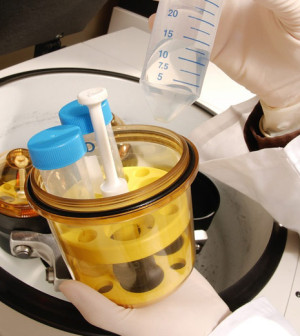- Navigating Your Midlife Crisis: Embracing New Possibilities
- City Raccoons Showing Signs of Domestication
- Mapping the Exposome: Science Broadens Focus to Environmental Disease Triggers
- One Week Less on Social Media Linked to Better Mental Health
- Your Brain Changes in Stages as You Age, Study Finds
- Some Suicide Victims Show No Typical Warning Signs, Study Finds
- ByHeart Formula Faces Lawsuits After Babies Sickened With Botulism
- Switch to Vegan Diet Could Cut Your Greenhouse Gas Emissions in Half
- Regular Bedtime Does Wonders for Blood Pressure
- Dining Alone Could Mean Worse Nutrition for Seniors
Outcomes Vary With Minimally Invasive Heart Valve Replacement


Nearly one-quarter of heart disease patients who underwent so-called transcatheter aortic valve replacement surgery died within a year, while roughly 4 percent had a stroke, new research reveals.
But some patients did well, the study found. Almost half who survived past one year weren’t re-hospitalized in that time, while less than one-quarter were readmitted once.
The findings provide insight into the potential upsides and downsides of a relatively new but increasingly popular procedure designed to restore blood flow and relieve heart strain for patients with severe aortic stenosis. This means their main heart valve no longer fully opens.
“In the past, the standard of care had been conventional surgery and total replacement of the aortic valve,” explained study lead author Dr. David Holmes, Jr., a cardiologist with the Mayo Clinic in Rochester, Minn. “But because of other medical conditions, as well as (advanced) patient age, a fair number of patients never got the conventional surgery.”
The newer procedure was initially approved to treat those patients, he added. Today, an estimated 30 percent of aortic stenosis patients choose to undergo transcatheter aortic valve replacement, Holmes said.
The new study findings suggest that the procedure does entail some degree of risk, but for patients with no other good option, “this procedure does improve their quality of life,” Holmes said.
“Doing nothing doesn’t work,” he added. “Yes, mortality was 24 percent within one year. But without this procedure mortality would’ve been substantially higher.”
Holmes, who chairs Mayo’s transcatheter valve therapy registry steering committee, reported his team’s findings in the March 10 issue of the Journal of the American Medical Association.
Transcatheter aortic valve replacement was approved by the U.S. Food and Drug Administration in 2011.
The American Heart Association describes it as “minimally invasive,” because an artificial aortic valve is guided into place by means of a catheter inserted into the groin. It doesn’t require removal of the injured valve.
Ideal candidates are those for whom traditional open heart surgery is too risky, the heart association says. Such patients are typically in their 70s or 80s.
For this report, investigators tracked more than 12,000 patients who underwent the procedure at about 300 U.S. hospitals between 2011 and 2013.
Patients’ median age was 84 (half were older, half younger), and 52 percent were women.
While about six in 10 patients were able to go home directly after the procedure was completed, 7 percent died within the first month, according to the report.
The study authors noted that the 24 percent of patients who died within the first year tended to be male, older and also had end-stage kidney disease and/or severe chronic obstructive pulmonary disease (COPD).
By contrast, female patients appeared to face a higher risk for stroke than males, the investigators found.
Holmes said the findings paint a more realistic picture for patients.
“There will be some patients who will say it seems pretty great after seeing this information,” he said. “There are some who will say, ‘Gosh, I’m 90 but if this can improve my quality of life I’ll go for it.’ There will be others who will just want to stay the course and see how things go,” Holmes added.
“The important part is we now have data that we can use to improve patient-centric conversations,” he explained.
The cost of the transcatheter aortic valve replacement procedure averages about $91,000, according to a study published in 2012 in the Journal of the American College of Cardiology.
The authors of the current study pointed out that repeat hospitalizations are costly and affect quality of life. Patients may want to consider these factors as they weigh the pros and cons of the procedure.
Dr. Gregg Fonarow, a professor of cardiology at the University of California, Los Angeles, described transcatheter aortic valve replacement as a “very important therapeutic advance.”
The study “provides important insights into one-year real world outcomes,” Fonarow said. He also added that the findings seem to back up the results of other studies recently conducted outside the United States.
However, he cautioned that the current study did not actually look at how transcatheter aortic valve replacement patients fared compared with similar patients who did not undergo the procedure. Such side-by-side comparison will be needed, Fonarow said, in order to identify which patients with severe aortic stenosis will benefit most from the procedure.
More information
For more on transcatheter aortic valve replacement, visit the American Heart Association.
Source: HealthDay
Copyright © 2025 HealthDay. All rights reserved.










